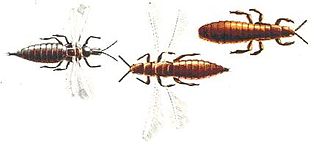
Thrips are minute, slender insects with fringed wings and unique asymmetrical mouthparts. Entomologists have described approximately 7,700 species. They fly only weakly and their feathery wings are unsuitable for conventional flight; instead, thrips exploit an unusual mechanism, clap and fling, to create lift using an unsteady circulation pattern with transient vortices near the wings.
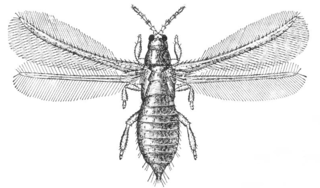
The Thripidae are the most speciose family of thrips, with over 290 genera representing just over two thousand species. They can be distinguished from other thrips by a saw-like ovipositor curving downwards, narrow wings with two veins, and antennae of six to ten antennomeres with stiletto-like forked sense cones on antennal segments III and IV.

Orthotospovirus is a genus of negative-strand RNA viruses, in the family Tospoviridae of the order Bunyavirales, which infects plants. Tospoviruses take their name from the species Tomato spotted wilt orthotospovirus (TSWV) which was discovered in Australia in 1919. TSWV remained the only known member of the family until the early 1990s when genetic characterisation of plant viruses became more common. There are now at least twenty species in the genus with more being discovered on a regular basis. Member viruses infect over eight hundred plant species from 82 different families.

Scirtothrips dorsalis, the chilli thrips or yellow tea thrips, is an extremely successful invasive species of pest-thrips which has expanded rapidly from Asia over the last twenty years, and is gradually achieving a global distribution. It has most recently been reported in St. Vincent (2004) Florida (2005), Texas (2006), and Puerto Rico (2007). It is a pest of economic significance with a broad host range, with prominent pest reports on crops including pepper, eggplant, mango, citrus, strawberry, grapes, cotton, tea, peanuts, blueberry, and roses. Chilli thrips appear to feed preferentially on new growth, and infested plants usually develop characteristic wrinkled leaves, with distinctive brown scarring along the veins of leaves, the buds of flowers, and the calyx of fruit. Feeding damage can reduce the sale value of crops produced, and in sufficient numbers, kill plants already aggravated by environmental stress. This thrips has also been implicated in the transmission of three tospoviruses, but there is some controversy over its efficiency as a vector.
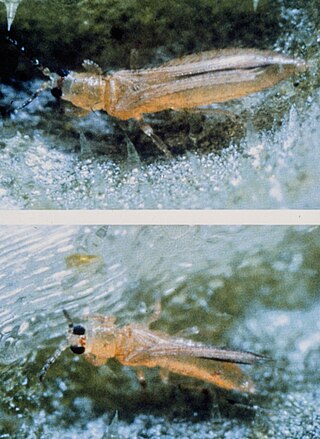
Thrips palmi is an insect from the genus Thrips in the order Thysanoptera. It is known commonly as the melon thrips.
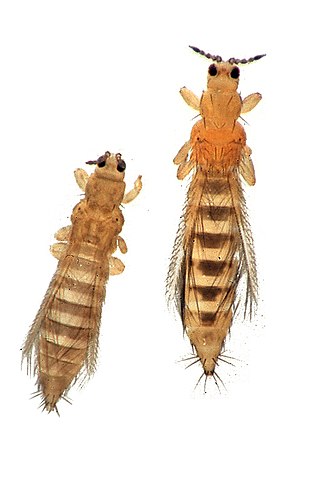
The Thripinae are a subfamily of thrips, insects of the order Thysanoptera. The Thripinae belong to the common thrips family Thripidae and include around 1,400 species in 150 genera. A 2012 molecular phylogeny found that the Thripinae was paraphyletic; further work will be needed to clarify the relationships within the group.

Thrips is a genus of insect in the order Thysanoptera.
Frankliniella schultzei, the common blossom thrips or cotton thrips, is a species of thrips in the family Thripidae. It is found in many parts of the world and is an important pest insect in agriculture.
Neohydatothrips is a genus of thrips in the family Thripidae. There are at least 30 described species in Neohydatothrips.
Psilothrips pardalotus is a species of thrip in the family Thripidae. It is found in North America.
Psilothrips is a genus of thrips in the family Thripidae. There are at least two described species in Psilothrips.

Gynaikothrips ficorum, the Cuban laurel thrips, is a species of tube-tailed thrip in the family Phlaeothripidae. It is found in Africa, North America, and Europe. It is widespread around the world because of its host, Ficus.

Gynaikothrips is a genus of tube-tailed thrips in the family Phlaeothripidae. There are more than 30 described species in Gynaikothrips.
Neurothrips is a genus of tube-tailed thrips in the family Phlaeothripidae. There are about six described species in Neurothrips.
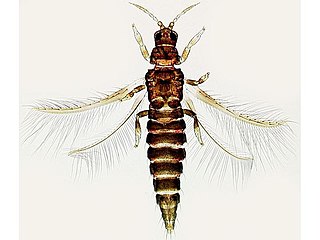
Echinothrips americanus is a species of thrips in the family Thripidae. It is found in North America, Europe, and Asia. E. americanus was first described in 1913 by entomologist A.C. Morgan in Quincy, Florida, where he found the insect on a Veratrum viride plant. Suggested common names include Poinsettia thrips and Impatiens thrips. Since their spread throughout Europe as early as 1995, and subsequently China, E. americanus has been called an "upcoming pest."
Aeolothrips collaris is a species of predatory thrip in the family Aeolothripidae. It is found in Africa, Europe and Northern Asia, and North America.
Aeolothrips kuwanaii is a species of predatory thrip in the family Aeolothripidae. It is found in North America.
Torvothrips is a genus of tube-tailed thrips in the family Phlaeothripidae. There are at least two described species in Torvothrips.
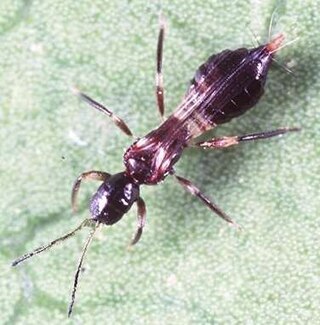
Franklinothrips vespiformis, the vespiform thrips, is a species of predatory thrip in the family Aeolothripidae. It is found in the Caribbean, Central America, North America, Oceania, South America, Southern Asia, and Europe. It has been used in biological control of Bemisia tabaci.

Neohydatothrips variabilis, the soybean thrips, is a species of thrips in the family Thripidae. It is found in Central America and North America.










